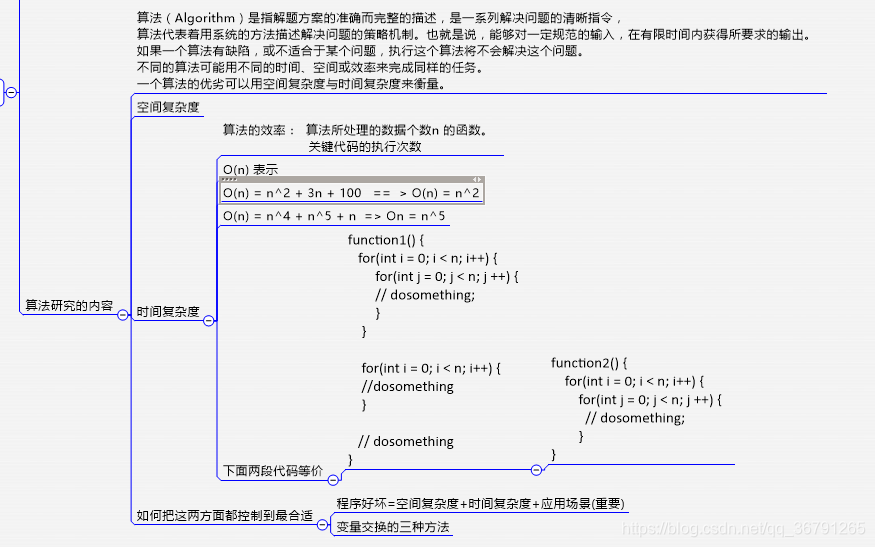算法
是解决问题的一种具体,清晰的描述,是程序解决问题的清楚指令。
简介:
算法代表着用系统的方法描述解决问题的策略机制。也就是说,能够对一定规范的输入,在有限时间内获得所要求的输出。
如果一个算法有缺陷,或不适合于某个问题,执行这个算法将不会解决这个问题。
不同的算法可能用不同的时间、空间或效率来完成同样的任务。
一个算法的优劣可以用空间复杂度与时间复杂度来衡量。

数据结构
数据结构是数据存储和数据组织的方式,是值一个或多个数据元素之间的结构关系。
按逻辑结构分:
线性结构,树形结构,图形结构,集合结构。

按存储结构分:
表、数组、堆栈、队列、树、二叉树、图。
线性表
数据结构中的一种线性表现,即线性存储数据的形式展现。
顺序存储结构,链表存储结构
应用:数组,链式结构LinkList等

顺序存储结构
优点:查找方便,支持随机访问,尾部插入方便 存储空间利用率高
缺点:中间插入麻烦,删除麻烦
将数据线性存储。经典的例子就是数组和ArrayList
排序相关处理 : 冒泡法(暴力法),选择排序
public class ExampleUnitTest {
@Test
public void addition_isCorrect() throws Exception {
assertEquals(4, 2 + 2);
}
@Test
public void testSwap() {
int a = 5;
int b = 6;
//1 可读性最好的
// int t=a;a=b;b=t;
//2
// a=a+b;// a=11 b=6
// b=a-b;// a=11 b=5
// a=a-b;// a=6 b=5
//3 性能最优(没有可读性) 无人机 跑步
a = a ^ b;
b = a ^ b;
a = a ^ b;
System.out.println("a=" + a + "--- b=" + b);
}
public int testSreach(int[] array, int des) {
for (int i = 0; i < array.length; i++) {
if(array[i]==des){
return i;
}
}
return -1;
}
@Test
public void testCards(){
Cards[] array=new Cards[]{
new Cards(3,2),new Cards(2,9),new Cards(1,7),
new Cards(3,5),new Cards(4,3)
};
// Arrays.sort(array);//100行以上
bubbleSort(array);
for (Cards cards : array) {
System.out.println(cards.toString());
}
}
@Test
public void testSort(){
int[] array=new int[]{3,2,5,8,1,9,4,6,7};
for (int i : array) {
System.out.print(i+" ");
}
System.out.println("\n");
// bubbleSort(array);
selectSort(array);
for (int i : array) {
System.out.print(i+" ");
}
}
public static void bubbleSort(int[] array){
//3 1 5 8 2 9 4 6 7 n*(n-1)/2 n
for(int i=array.length-1;i>0;i--) {
boolean flag=true;
for (int j = 0; j < i; j++) {
if (array[j] > array[j + 1]) {
int temp = array[j];
array[j] = array[j + 1];
array[j + 1] = temp;
flag=false;
}
}
if(flag){
break;
}
}
}
public static void bubbleSort(Cards[] array){ //3-5个数据 78
//1 2 3 4 5 9 4 6 7 n*(n-1)/2 n
for(int i=array.length-1;i>0;i--) {
boolean flag=true;
for (int j = 0; j < i; j++) {
if (array[j].compareTo(array[j+1])>0) {
Cards temp = array[j];
array[j] = array[j + 1];
array[j + 1] = temp;
flag=false;
}
}
if(flag){
break;
}
}
}
public static void selectSort(int[] array){
for(int i=0;i<array.length-1;i++) {
int index = i;
for (int j = i+1; j < array.length; j++) {
if (array[j] < array[index]) {
index = j;
}
}
//{1,2,5,8,3,9,4,6,7};
if(index!=i) {//如果已经是最小的,就不需要交换
int temp = array[index];
array[index] = array[i];
array[i] = temp;
}
}
}
}
public class Cards implements Comparable{
public int pokerColors;//花色
public int cardPoints;//点数
public Cards(int pokerColors, int cardPoints) {
this.pokerColors = pokerColors;
this.cardPoints = cardPoints;
}
//提供一个方法,用来比较对象的大小
@Override
public int compareTo(@NonNull Object o) {
Cards c=(Cards)o;
if(this.cardPoints>c.cardPoints){
return 1;
}else if(this.cardPoints<c.cardPoints){
return -1;
}
if(this.pokerColors>c.pokerColors){
return 1;
}else if(this.pokerColors<c.pokerColors){
return -1;
}
return 0;
}
@Override
public String toString() {
return "Cards{" +
"pokerColors=" + pokerColors +
", cardPoints=" + cardPoints +
'}';
}
}链式存储结构
分为双向链表和单向链表
缺点:存储空间利用率低,分两部分存储,占用空间多
优点:增加方便,删除方便
建立链表Code:
public class LinkedList<E> {
/**
* 结点
*/
private static class Node<E> {
E item;
Node<E> prev;
Node<E> next;
public Node(Node<E> prev, E item, Node<E> next) {
this.item = item;
this.prev = prev;
this.next = next;
}
}
public LinkedList() {
}
//头节点
Node<E> first;
//尾节点
Node<E> last;
//大小
int size;
/**
* 添加数据在最后
*/
public void add(E e) {
linkLast(e);
}
/**
* 添加到最后
* @param e
*/
private void linkLast(E e) {
Node<E> newNode = new Node<E>(last, e, null);
Node<E> l = last;
last=newNode;
if(l==null){
first=newNode;
}else {
l.next = newNode;
}
size++;
}
/**
* 查找位置
*/
public E get(int index){
if(index<0 || index>size){
return null;
}
return node(index).item;
}
/**
* 获取index位置上的节点
*/
private Node<E> node(int index){
//如果index在整个链表的前半部分
if(index<(size>>1)){ //1000 100 10
Node<E> node=first;
for (int i = 0; i < index; i++) {
node=node.next;
}
return node;
}else{
Node<E> node=last;
for (int i = size-1; i > index; i--) {
node=node.prev;
}
return node;
}
}
/**
* 添加数据在index位置
*/
public void add(int index,E e) {
if(index<0 || index>size){
return ;
}
if(index==size){
linkLast(e);
}else{
Node<E> target=node(index);// index=2
Node<E> pre=target.prev;
Node<E> newNode=new Node<E>(pre,e,target);
if(pre==null){
first=newNode;
target.prev = newNode;//4
}else {
pre.next = newNode;//3
target.prev = newNode;//4
}
size++;
}
}
/**
* 删除元素
*/
public void remove(int index){
Node<E> target=node(index);
unlinkNode(target);
}
private void unlinkNode(Node<E> p) {//index=2
Node<E> pre=p.prev;
Node<E> next=p.next;
if(pre==null){
first=p.next;
}else{
pre.next=p.next;
}
if(next==null){
last=p.prev;
}else{
next.prev=p.prev;
}
size--;
}
}
例子:LinkList 单向链表是每个数据单元指向下一个,而下一个不能指向上一级。 而双向列表就是每个数据单元指向上一级和下一级。
两个结合的例子就是hashtable 因为数据过大,链表就不好用了所以 jdk1.8之后的大改版,设定了阈值,超过一定数量就应用红黑树存储。以后再会介绍。
hashtable如下图:

红黑树如下图:

链式排序相关:
链式基数排序。
适用:数据量小,插入过多时如麻将问题。

麻将插入代码
创建麻将对象类:
public class Mahjong {
public int suit;//筒,万,索
public int rank;//点数 一 二 三
public Mahjong(int suit, int rank) {
this.suit = suit;
this.rank = rank;
}
@Override
public String toString() {
return "("+this.suit+" "+this.rank+")";
}
}排序:
public static void radixSort(LinkedList<Mahjong> list){
//先对点数进行分组
LinkedList[] rankList=new LinkedList[9];
for (int i = 0; i < rankList.length; i++) {
rankList[i]=new LinkedList();
}
//把数据一个个放到对应的组中
while(list.size()>0){
//取一个
Mahjong m=list.remove();
//放到组中 下标=点数减1的
rankList[m.rank-1].add(m);
}
//把9组合并在一起
for (int i = 0; i < rankList.length; i++) {
list.addAll(rankList[i]);
}
//先花色进行分组
LinkedList[] suitList=new LinkedList[3];
for (int i = 0; i < suitList.length; i++) {
suitList[i]=new LinkedList();
}
//把数据一个个放到对应的组中
while(list.size()>0){
//取一个
Mahjong m=list.remove();
//放到组中 下标=点数减1的
suitList[m.suit-1].add(m);
}
//把3个组合到一起
for (int i = 0; i < suitList.length; i++) {
list.addAll(suitList[i]);
}
}测试Dome
@Test
public void addition_isCorrect() throws Exception {
LinkedList<Mahjong> list=new LinkedList<Mahjong>();
list.add(new Mahjong(3,1));
list.add(new Mahjong(2,3));
list.add(new Mahjong(3,7));
list.add(new Mahjong(1,1));
list.add(new Mahjong(3,8));
list.add(new Mahjong(2,2));
list.add(new Mahjong(3,2));
list.add(new Mahjong(1,3));
list.add(new Mahjong(3,9));
System.out.println(list);
radixSort(list);
System.out.println(list);
}





















 1660
1660











 被折叠的 条评论
为什么被折叠?
被折叠的 条评论
为什么被折叠?








